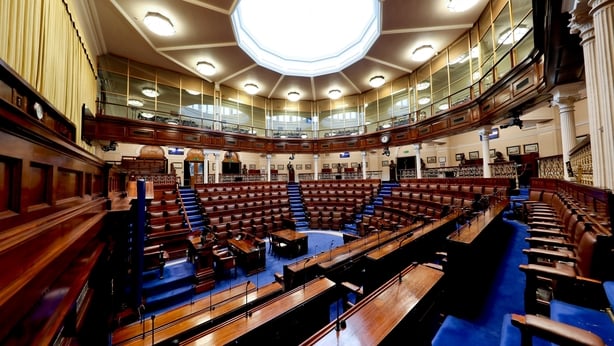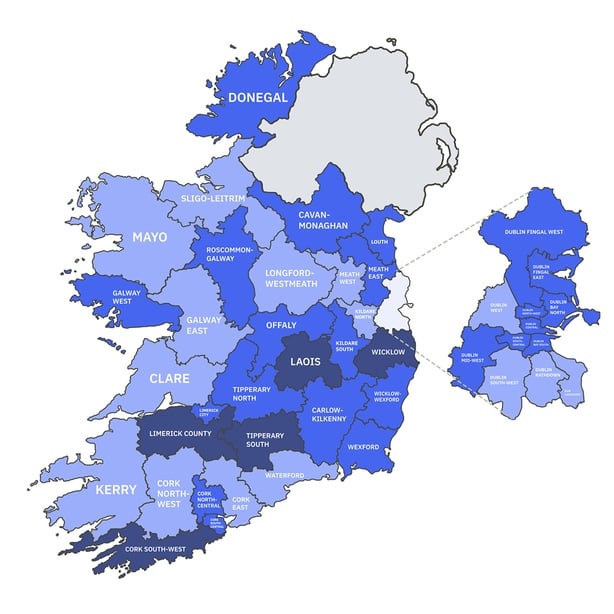This is your home for General Election 2024.
View: Interactive map of 43 constituencies and candidate lists
When is polling day?
On Friday 29 November, voters cast their ballots to elect the new TDs of the 34th Dáil.
But before that, candidates up and down the country were out vying for your vote, hoping to be your #1.
If you're 18 or over on polling day, resident in Ireland, an Irish or British citizen, and registered to vote, you can vote in the General Election.
As it stands, Irish citizens living abroad can only vote if they are in the country on election day.
Exceptions are made in certain circumstances to allow for postal voting, such as for members of the Irish Defence Forces stationed abroad, diplomats and their spouses posted abroad, and voters with physical illnesses or disabilities.
Who are the candidates?

There are 686 candidate nominations in the running to contest Election 24. Of them, 246 are women.
To see who is running in your area, you can click here and select your constituency.
There will be 174 TDs in the next Dáil. That's 14 more than the previous Dáil.
No single party is fielding enough candidates to win a majority on its own in the next Dáil.
There is a significant number of Independents (171) contesting the election. Then, looking at the numbers, here is how many candidates each party is running.
Fianna Fáil (82)
Fine Gael (80)
Sinn Féin (71)
Aontú (43)
Green Party (43)
People Before Profit-Solidarity (42)
Labour Party (32)
Independent Ireland (28)
Social Democrats (26)
Irish People (21)
Irish Freedom Party (16)
National Party (9)
Liberty Republic (6)
Centre Party of Ireland (3)
Independents 4 Change (3)
Party for Animal Welfare (3)
Rabharta (3)
Ireland First (2)
100% Redress (1)
Right to Change (1)
One TD already knows his fate - the Ceann Comhairle, currently Seán Ó Fearghaíl, is automatically re-elected as a member of the next Dáil. To include him would bring Fianna Fáil numbers up to 83, with a total of 686 candidates.
At the close of nominations, the constituency with the most candidates was Louth - at 24. The constituency of Wicklow-Wexford had the fewest - at 10.
How many constituencies are there?

There are 43 constituencies this time round. That's a change from Election 2020 when there were 39. Where did the extra constituencies come from, you might wonder? The Electoral Commission proposed various constituency changes after a review - some of the biggest reforms include:
Dublin Fingal: It used to be one constituency but has now been split into Dublin Fingal East and Dublin Fingal West.
The former constituency of Laois-Offaly has been separated in two - Laois and Offaly.
Tipperary has become Tipperary North and Tipperary South.
And you might remember hearing previously about the new constituency of Wicklow-Wexford, taking in south Wicklow and north Wexford, as it was a big talking point when the Electoral Commission’s proposes were first announced.
There are plenty of other constituency changes too. For the deep dive on this, you can read all about the boundary changes here.
What's my constituency?
To get a broad sense of the new electoral map, our map above shows all 43 constituencies. And an interactive version is available on our main constituency page.
And the Electoral Commission has a handy tool on its site, called 'Find My Constituency'. An Irish and an English version is available:
What's my constituency?
Cén Dáilcheantar ina gcónaím?
So what are the constituencies?
Some constituencies will elect three TDs, some four and others will see five TDs elected. Below is the breakdown. You can click on each constituency link below for more information.
Three-seater constituencies
Cork North-West
Cork South-West
Dublin Fingal East
Dublin Fingal West
Laois
Offaly
Limerick County
Meath West
Roscommon-Galway
Tipperary North
Tipperary South
Wicklow-Wexford
Four-seater constituencies
Clare
Cork East
Dublin Bay South
Dublin Central
Dublin Rathdown
Dublin South-Central
Dún Laoghaire
Galway East
Kildare South
Limerick City
Meath East
Sligo-Leitrim
Waterford
Wexford
Wicklow
Five-seater constituencies
Carlow-Kilkenny
Cavan-Monaghan
Cork North-Central
Cork South-Central
Donegal
Dublin Bay North
Dublin Mid-West
Dublin North-West
Dublin South-West
Dublin West
Galway West
Kerry
Kildare North
Longford-Westmeath
Louth
Mayo
Looking for your #1
When it comes to polling day, you'll vote for your preferred candidates in order of preference, giving #1 to your first preference. Then you can choose if you wish to continue to rank others, #2, #3, #4 etc.
It's a system called Proportional Representation, Single Transferable Vote (PR-STV). Unlike the 'first past the post' voting system used in other countries, PR-STV makes for a more lengthy counting process where 'transfers' are often a crucial part of getting elected.
Some constituencies might see the count lasting several days. Louth, with its 25 candidates, is probably a good guess this time out for a very lengthy count!
You can read more about proportional representation voting here.
And when will we know the outcome?
The election of the TDs of the 34th Dáil is one part of the story. The next part of the story is who forms the government.
The public do not elect a taoiseach when we vote on polling day. We vote for individual TDs to represent our constituency.
The new arithmetic means that in a Dáil of 174 TDs, a party would need at least 88 TDs elected to win a majority to form a government. But as we mentioned above, no one party is fielding enough candidates to do so.
Normally, if a party wins a majority, a clear picture emerges quickly.
But, as we saw with the last election, when no single party wins enough seats to emerge victorious, we can see months of talks and negotiations between various parties and groupings and Independents.
Those discussions in 2020 ultimately led to the creation of a coalition of parties - Fine Gael, Fianna Fáil and the Green Party - as the Government of the day.
What shape the next government will take is something that might not be clear for many weeks yet.
So there's much to discuss and consider for both politicians and the public in advance of voting day.

